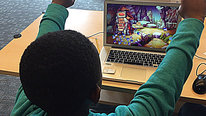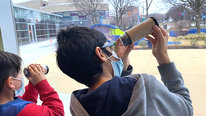Blog for January 2023: Embracing Neurodiversity in STEM
Posted by: Jodi Asbell-Clarke on January 3, 2023The term neurodiversity was introduced by the Australian sociologist Judy Singer, in 1999, steering away from judgmental terms such as learning disorder or learning disabled to describe differences in how people learn. A neurodiversity approach considers each person as having a unique brain with a unique set of strengths and weaknesses. Terminology that pathologizes differences—labeling them as disorders, disabilities, or syndromes—is seen to place the burden of change on the learner, while a neurodiversity perspective suggests we should consider how the learning environment and experiences can change so all learners are supported to thrive in their own ways.
It is difficult to make generalizations about the huge variations in neurodiversity. Some forms of neurodivergence, such as autism, ADHD, and dyslexia, have common features and behaviors, but even these are seen to vary greatly among individuals. Also many of these differences are often coincident with one another, meaning people exhibit indicators of more than one at a time. This is yet another reason why each learner should be regarded as unique and having specific assets, as well as challenges, for learning.
Sometimes differences in how people learn are congenital, due to the physical and chemical conditions with which the brain was born. Sometimes the differences are temporal and can change from day to day depending on the amount of food, sleep, and stress the brain has recently experienced. Sometimes brain functions are altered by trauma or neglect. No matter what the cause, each individual goes throughout their day with a unique set of physical, social, emotional, and cognitive circumstances. Recognizing and supporting these differences is key to inclusive learning.
The projects discussed on this panel focus on STEM problem solving, which requires adopting novel perspectives, generating new and innovative options for solutions, systematically and efficiently testing alternatives to find the optimal solutions, and then effectively and efficiently implementing those solutions with a high degree of fidelity. This work requires creativity, persistence, attention to detail, systematic thinking, flexibility, and clear communication.
A growing body of research points to a strong connection between these STEM problem-solving skills and neurodiversity. For example, some researchers hypothesize low arousability associated with ADHD may lead to higher drives for sensation-seeking and more stimulation-seeking behaviors, which in turn may lead to greater flexibility, openness to experience, preference for complexity, and receptivity to novel ideas and experiences [White & Shah, 2006]. Another body of emerging research suggests an alignment between autism and systemic ways of thinking and processing patterns. People with autism have been found to score higher on logic and pattern recognition puzzles than the general population. Pattern recognition has also been proposed as a primary basis for particular talents associated with autism (also known as savant behaviors), such as calendar calculating, mathematics, and other specialized skills [Mottron et al., 2009; Baron-Cohen et al., 2008]. Finally, growing research indicates people with dyslexia may have particular strengths in system thinking, particularly in the areas of spatial reasoning and seeing connections between elements of a system.
Delivering educational experiences that reveal and nurture these talents, while also supporting the unique cognitive, emotional, and social needs of each learner, is called differentiation. Differentiation practices that promote strong problem-solving skills among neurodivergent learners take into account specialized talents and interests, as well as customized supports. This requires a rethink of how learning, teaching, and assessments take place in school.
The pedagogical approaches used to include neurodivergent learners in STEM problem solving often focus on promoting learner autonomy and agency, so the learner is able to help shape the learning experience for themselves. By allowing neurodivergent learners to work on a problem in their own way, their unique talents can emerge. Examples of pedagogical approaches conducive to successful differentiation include game-based learning, project-based learning, and making, where learners are typically more in control of the learning experience and divergent ways of thinking may be rewarded rather than discouraged.
While these pedagogical approaches and disciplines embrace the talents of neurodiversity, supports are still needed to deal with the challenges many neurodivergent learners face. For example, on any given day, any learner may be facing executive function challenges. The term executive function is used to describe the activity of the executive network of the brain in conducting goal-oriented tasks, which often includes: paying attention to instructions, inputting information, building new understandings, and completing tasks. In STEM problem solving, executive function is needed for planning, organizing information, discerning salient information from the “noise”, and monitoring progress towards the goal.
To differentiate teaching and learning experiences for all learners successfully, meaning to provide autonomy and agency while supporting executive function and other needs, educators require effective forms of instruction, engagement, and assessment that can support and measure learning in ways that help neurodiversity thrive. Each learner, on each new day, may experience learning differently. Some days a learner may be able to engage in keen attention and high executive function processes and be ready for a big new adventure. On another day, even the slightest risk or jarring experience may be overwhelming and shut them down. Taking these differences among and within learners into consideration will help promote engagement and persistence, as well as productivity, in learning, particularly in complex tasks such as STEM problem solving.
This panel illustrates different projects that highlight the strengths of neurodivergent learners while also supporting their learning challenges. We encourage you to view these excellent 3-minute videos featuring their work:





